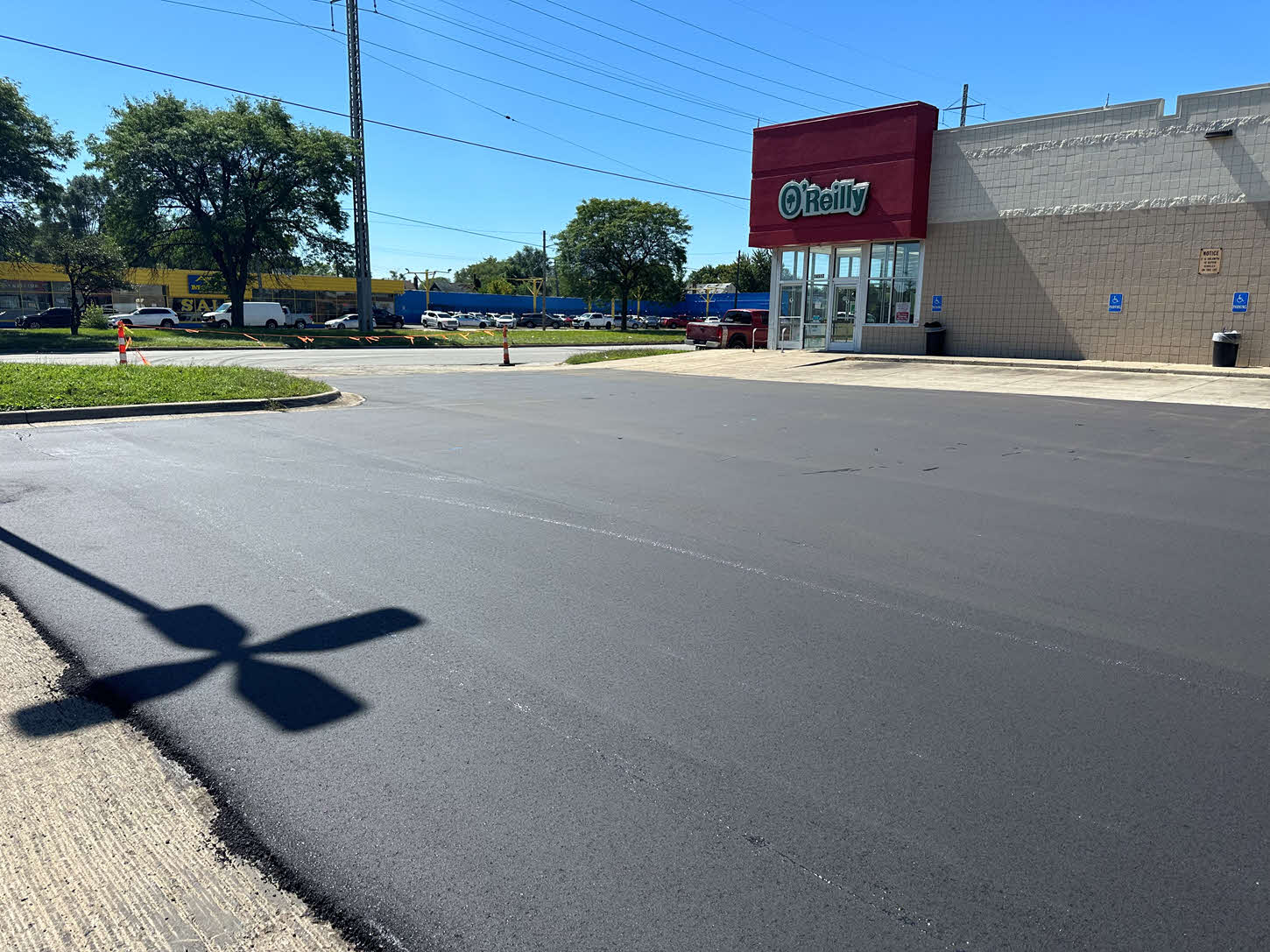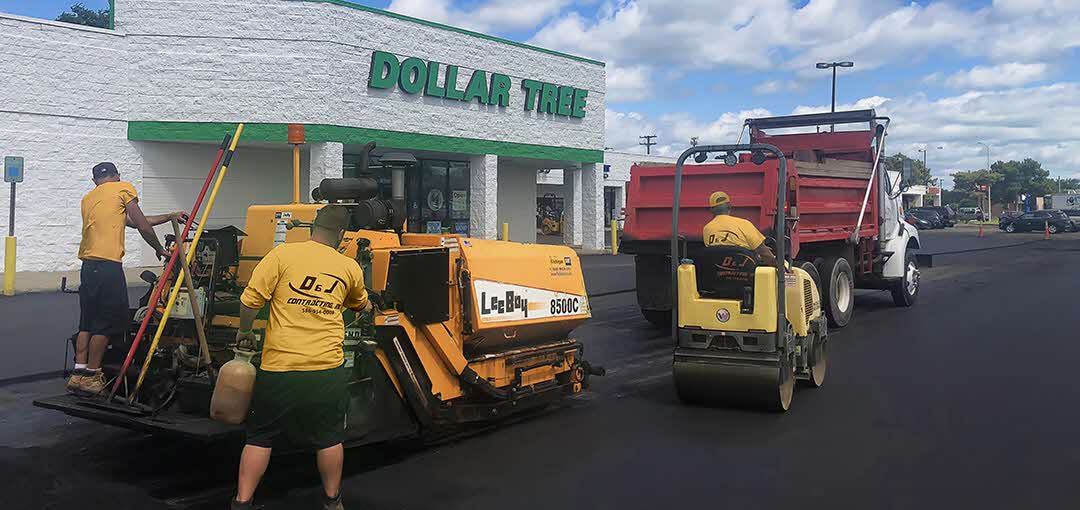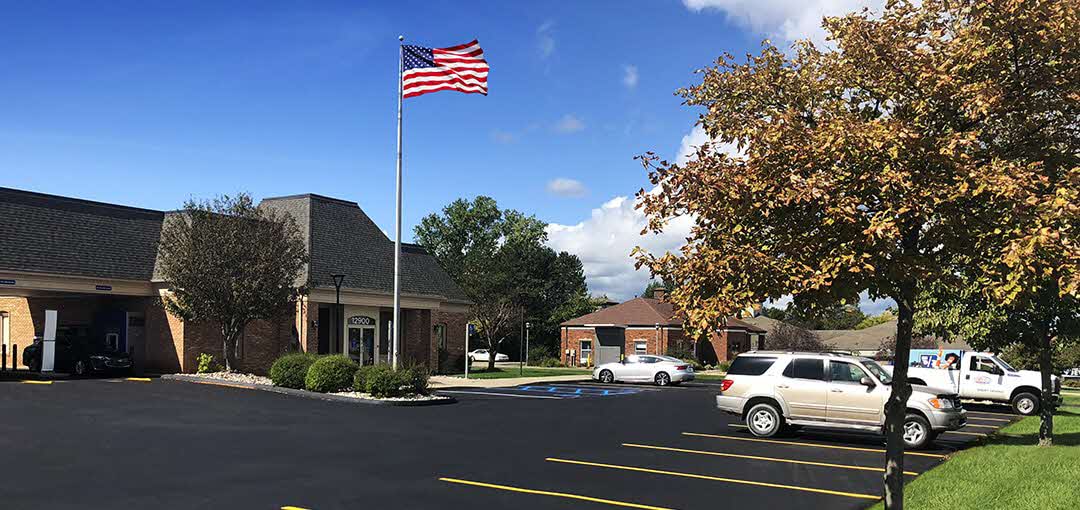Overlay inNew Baltimore, MI
Durable Overlay Solutions for a Stronger, Longer-Lasting Surface
We Are Locally Owned & Operated For Over 37 Years
Contact Us Today!
We Serve Businesses In And Around The Following Cities:
About Overlay
Overlay in New Baltimore for Commercial Properties
Understanding Overlay and Its Importance
In the vibrant economic landscape of New Baltimore, businesses are continuously seeking ways to enhance their commercial properties and maintain competitiveness. A solution that’s notably gaining traction in commercial property management is the use of overlays. This process, encompassing Parking Lot Asphalt Overlay and Durable Surface Application, has become a cornerstone for property managers aiming to extend the viability of their surfaces without the need for complete reconstruction.
Overlay is a surface rehabilitation technique that involves placing a new layer of material over an existing surface, such as asphalt, to restore its structural integrity and aesthetic appeal. In bustling commercial areas like New Baltimore, where traffic and environmental conditions are harsh, overlays offer a pragmatic way to prolong the lifespan of parking areas and other commercial surfaces. This method not only addresses immediate repair needs but also serves as a preventive measure against further deterioration.
The Overlay Process: Steps and Considerations
The process of overlaying begins with a thorough assessment of the site. This involves identifying all surface distress signs such as cracks, potholes, and base failures. In a busy city like New Baltimore, it’s imperative that this assessment is both comprehensive and swift to minimize operational disruptions for businesses. Once the assessment is complete, the next phase involves surface preparation, which may include cleaning, milling, or leveling to ensure the new layer adheres properly.
The choice of material for the overlay is critical. In New Baltimore’s varied climate, asphalt stands out as a preferred material due to its flexibility, durability, and cost-effectiveness. The application of the asphalt overlay is meticulously executed to ensure even spread and compaction, creating a smooth, resilient surface that is ready to handle heavy traffic loads. D&J Contracting’s expertise in this area ensures that each step of the process adheres to the highest standards, making it a trusted choice for commercial property owners.
An essential feature of a successful overlay is the incorporation of Durable Surface Application techniques. This includes the use of advanced materials and application methods designed to withstand intense usage and weather conditions. Businesses in New Baltimore often opt for these techniques to enhance the longevity and performance of their parking lots.
Benefits of Overlay for Commercial Properties
The advantages of overlaying surfaces in commercial properties are manifold. Primarily, the economic benefits are significant. Compared to full-scale surface reconstruction, overlaying is notably cost-effective, allowing businesses to allocate funds towards other essential operations. In New Baltimore, where property aesthetics can significantly influence customer attraction, an overlay offers a quick facelift to worn-out surfaces, enhancing curb appeal and inviting customer traffic.
Moreover, overlays bring about notable environmental benefits. By minimizing the need for new materials and reducing waste associated with complete removals, businesses contribute to sustainable development—a key consideration in modern urban planning. Property owners in New Baltimore who invest in Parking Area Rehabilitation through overlays observe an immediate reduction in their carbon footprint, aligning with broader municipal goals of environmental responsibility.
Operational efficiency is another clear benefit. With the execution of quick and effective overlay services, downtown businesses face minimal downtime, ensuring continued access to their facilities. The swift turnaround time, particularly with D&J Contracting’s proficient handling, means commercial entities can resume full operations with minimal disruptions.
Real-World Applications and Success Stories
The practical application of overlays is as diverse as the commercial landscape of New Baltimore itself. From retail spaces to office complexes, many properties benefit from Parking Lot Asphalt Overlay services. For instance, a prominent retail landmark observed a dramatic increase in customer satisfaction and foot traffic after restoring its parking facilities through a well-executed overlay. The renewed surface improved both navigation and safety, contributing to an enhanced shopping experience.
Service-oriented sectors such as healthcare facilities have also turned to overlays to manage their high-traffic areas. A notable healthcare provider in New Baltimore employed D&J Contracting for overlay services, resulting in improved accessibility and safety for its patrons. This investment not only reinforced the surface strength of its parking lot but also ensured compliance with accessibility standards, showcasing a commitment to community welfare.
Additionally, overlay has proven beneficial for multi-tenant commercial properties like business parks. Tenants appreciate the consistent upkeep provided by property managers through overlay installations, as it ensures they maintain unimpeded access to their offices. D&J Contracting has consistently been a preferred contractor for these dimensions, providing tailored solutions that cater to the specific needs of these facilities.
Key Considerations for Businesses
When contemplating an overlay for commercial property, it’s vital for businesses in New Baltimore to account for both immediate needs and long-term objectives. Knowing that a parking lot overlay can rejuvenate a facility’s appearance and utility, property managers should align these enhancements with strategic planning. Consider future traffic patterns, anticipated growth, and potential environmental impact to make informed decisions.
Moreover, selecting a reliable contractor like D&J Contracting ensures that the overlay process is completed efficiently and effectively. Their team’s ability to customize solutions according to unique property requirements makes them an ideal partner for businesses seeking durable and cost-efficient results. By integrating professional expertise, businesses can expect a seamless overlay process that not only meets but exceeds their expectations.
Engaging with the local community by choosing services that support local businesses, such as D&J Contracting, further forts a connection with New Baltimore’s vibrant economic ecosystem. This approach reinforces a positive company image and supports local economic growth.
Overall, investing in overlay services reflects a commitment to maintaining a functional, attractive, and sustainable commercial property. For New Baltimore businesses, it’s a strategy that delivers immediate and long-term benefits, strengthening their position in a competitive market.
As the commercial landscape of New Baltimore continues to evolve, the need for adaptable and sustainable solutions such as overlay becomes increasingly paramount. By embracing these strategies, businesses are better positioned to thrive, ensuring their properties are not only functionally optimized but also visually appealing. For those seeking guidance and execution in this undertaking, reaching out to experienced contractors like D&J Contracting is a wise step, offering assurance in quality and expertise.
Overlay Gallery


Call Us Today to receive your Free Quote for
Overlay in New Baltimore
Serving: New Baltimore, Michigan

About New Baltimore, Michigan
New Baltimore incorporated as a village in 1867 and as a city in 1931. Previously, it was split between Macomb and St. Clair counties; however, in the 1970s, the city was able to petition to adjust the county boundaries such that it would align with the city’s eastern border. This placed New Baltimore completely in Macomb County, where it remains to this day. The town sits on the waterfront along Lake St. Clair’s Anchor Bay, and offers a public park, beach, and downtown-shopping district.
Prior to the arrival of European settlers, indigenous tribes are known to have inhabited much of New Baltimore’s shoreline for thousands of years, and in the 1800s the land was recorded to have many ancient burial mounds and man made earth-works. W.B Hinsdale excavated multiple sites in New Baltimore, and recorded his countless findings in his novels in the early 20th century. Most of these locations have long been destroyed by treasure hunters and developed over, with an unfortunate though seemingly familiar lack of regard to the public’s knowledge of the city’s vast history with indigenous tribes.
German explorer Pierre Yax (b.1763) in Grosse Pointe, New France (now Michigan) was the first recorded non-Native American in the New Baltimore area. Pierre Yax was a son of Johan Michael Jacks, the first German in what would eventually become the state of Michigan. Pierre Yax arrived in New Baltimore in 1796 and subsequently obtained a land grant signed by President John Quincy Adams on July 23, 1826. The land grant tracked back to a land patent Yax had in 1812, when Michigan was still part of the Michigan Territory.
Later, other French settlers came to this area and took residence along the waterfront and rivers. They developed farms that had narrow frontage of 400 of 900 feet and extended inland from the water. Generally, the depth of the parcel was determined by how far a man could plow or cultivate in a day.
The first evidence of a settled community came in 1845, when a Mount Clemens businessman, Alfred Ashley, platted 60 acres (24 ha) of land lying on both sides of Washington Street. This would become known as the village of Ashley. On September 20, 1851, a post office called Ashleyville was established with Ashley as postmaster. Ashley also opened businesses in lumbering, shipping, and real estate. The original village of Ashley occupied what is now the center part of downtown New Baltimore, extending northwest along Clay, Base and Maria Streets from Anchor Bay. The land was subdivided in the typical gridiron fashion used in most American communities at that time. Over the years, irregularities developed in the gridiron subdivision pattern because of the lack of local controls, conflicts with French claims, and changing land uses, particularly along the waterfront area. This created problems in both subdivision patterns in general and waterfront use in particular that remain today. This original settlement bore Ashley’s name until 1867, when the village name was changed to New Baltimore.
Throughout its history, New Baltimore has been linked to the regional economy by virtue of the city’s access to the waterfront and the region’s transportation network. In its early years, New Baltimore took advantage of its waterfront location to operate port facilities exporting agriculture and manufacturing products to other communities. The area was known for the manufacturing of barrels, brooms, bricks, coffins, corsets, and creamery products. Lumber products and building materials were shipped by boat from the local mills. Development was heavily oriented to the waterfront, where shipping piers extended a hundred or more feet into the lake.
As automobile transportation increased in importance and travel patterns changed, so did the development of the city. Goods were no longer shipped by water and the waterfront slowly changed. Between 1860 and 1880, New Baltimore changed from a strong manufacturing and exporting community to a thriving community in Macomb County with many resort activities and well-known commercial establishments. The community was a popular getaway spot for Metro Detroiters and boasted an opera house, hotels, salt baths (which nearby city of Mount Clemens was famous for in the late 19th and early 20th centuries), summer and winter recreational activities, saloons, a brewery and numerous resort and commercial establishments. The city was in the path of a steam locomotive line that ran between Detroit and Port Huron in the late 19th century. As technology changed, the city constructed an electricity plant to accommodate inter-urban passenger trains, which lasted until the mid-1920s. Today, access to the city is provided via Interstate 94. The historic New Baltimore water tower was demolished in the summer of 2015 and raised in the park to take its place was the State’s tallest flag. The flagpole stands at 160 feet tall on the shores of Anchor Bay at Walter and Mary Burke Park. The New Baltimore Lions Club raised more than $100,000 to have the flagpole installed with the intention of creating a landmark for boaters after the city’s historic water tower was demolished. A dedication ceremony took place in October 2016.
New Baltimore is in eastern Macomb County, with its eastern border following the St. Clair County line. It is on the northern shore of Anchor Bay, the northernmost part of Lake St. Clair. Highway M-29 passes through the city as Main Street, leading east 14 miles (23 km) to Algonac on the St. Clair River and west 4 miles (6 km) to Interstate 94 in Chesterfield Township. New Baltimore is 10 miles (16 km) northeast of Mount Clemens, the Macomb county seat.
According to the United States Census Bureau, the city has a total area of 6.73 square miles (17.43 km), of which 4.60 square miles (11.91 km) are land and 2.12 square miles (5.49 km), or 31.6%, are water.
| Census | Pop. | Note | %± |
|---|---|---|---|
| 1880 | 1,024 | — | |
| 1890 | 865 | −15.5% | |
| 1900 | 922 | 6.6% | |
| 1910 | 920 | −0.2% | |
| 1920 | 974 | 5.9% | |
| 1930 | 1,148 | 17.9% | |
| 1940 | 1,434 | 24.9% | |
| 1950 | 2,043 | 42.5% | |
| 1960 | 3,159 | 54.6% | |
| 1970 | 4,132 | 30.8% | |
| 1980 | 5,439 | 31.6% | |
| 1990 | 5,798 | 6.6% | |
| 2000 | 7,405 | 27.7% | |
| 2010 | 12,084 | 63.2% | |
| 2020 | 12,117 | 0.3% | |
| 2023 (est.) | 11,992 | −1.0% | |
| U.S. Decennial Census | |||
As of the census of 2010, there were 12,084 people, 4,434 households, and 3,187 families living in the city. The population density was 2,621.3 inhabitants per square mile (1,012.1/km). There were 4,740 housing units at an average density of 1,028.2 per square mile (397.0/km). The racial makeup of the city was 94.4% White, 2.7% African American, 0.4% Native American, 0.9% Asian, 0.2% from other races, and 1.4% from two or more races. Hispanic or Latino of any race were 1.8% of the population.
There were 4,434 households, of which 41.3% had children under the age of 18 living with them, 60.0% were married couples living together, 8.2% had a female householder with no husband present, 3.6% had a male householder with no wife present, and 28.1% were non-families. 23.3% of all households were made up of individuals, and 9.1% had someone living alone who was 65 years of age or older. The average household size was 2.72 and the average family size was 3.25.
The median age in the city was 37.1 years. 28.8% of residents were under the age of 18; 6.6% were between the ages of 18 and 24; 29.6% were from 25 to 44; 25.1% were from 45 to 64; and 9.8% were 65 years of age or older. The gender makeup of the city was 48.9% male and 51.1% female.
As of the census of 2000, there were 7,405 people, 2,942 households, and 1,994 families living in the city. The population density was 1,604.5 inhabitants per square mile (619.5/km). There were 3,218 housing units at an average density of 697.3 per square mile (269.2/km). The racial makeup of the city was 96.89% White, 0.53% African American, 0.36% Native American, 0.47% Asian, 0.04% Pacific Islander, 0.46% from other races, and 1.27% from two or more races. Hispanic or Latino of any race were 1.34% of the population.
There were 2,942 households, out of which 33.1% had children under the age of 18 living with them, 56.3% were married couples living together, 8.2% had a female householder with no husband present, and 32.2% were non-families. 27.4% of all households were made up of individuals, and 10.4% had someone living alone who was 65 years of age or older. The average household size was 2.48 and the average family size was 3.05.
In the city, the population was spread out, with 25.4% under the age of 18, 6.8% from 18 to 24, 34.3% from 25 to 44, 23.7% from 45 to 64, and 9.7% who were 65 years of age or older. The median age was 36 years. For every 100 females, there were 94.6 males. For every 100 females age 18 and over, there were 92.7 males.
The median income for a household in the city was $60,699, and the median income for a family was $72,046. Males had a median income of $49,648 versus $33,083 for females. The per capita income for the city was $26,921. About 1.0% of families and 3.5% of the population were below the poverty line, including 1.3% of those under age 18 and 8.0% of those age 65 or over.
New Baltimore is a home-rule city with an elected mayor and six at-large council members. Since 2022, Tom Semaan has served as mayor.
The city of New Baltimore is within the boundaries of the Anchor Bay School District, and hosts Lighthouse Elementary, Ashley Elementary, Anchor Bay Middle School North, and Anchor Bay’s Aquatic Center.
Call Us Today to receive your Free Quote for
Overlay in New Baltimore
Related Services in New Baltimore, Michigan
We Serve Businesses In The Following Zip Codes:
48007, 48015, 48021, 48026, 48035, 48036, 48038, 48042, 48043, 48044, 48045, 48046, 48047, 48048, 48050, 48051, 48066, 48071, 48080, 48081, 48082, 48083, 48084, 48085, 48088, 48089, 48090, 48091, 48092, 48093, 48098, 48099, 48225, 48230, 48236, 48310, 48311, 48312, 48313, 48314, 48315, 48316, 48317, 48318, 48397